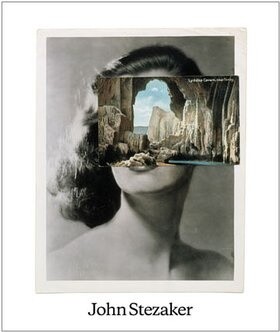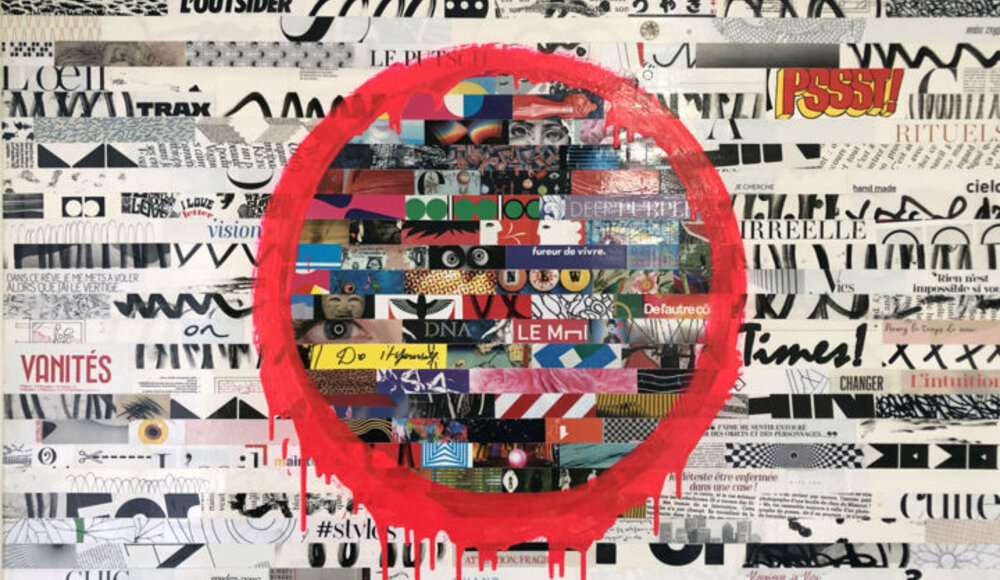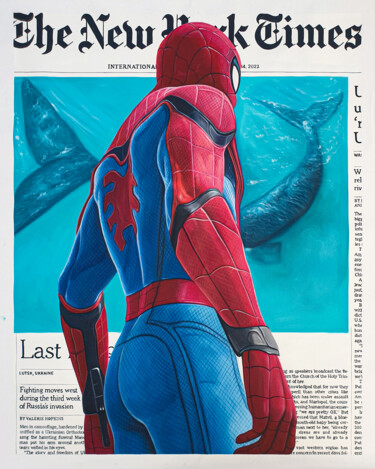 CIRCLE 3 (2021)Collages by Morgan Paslier.
CIRCLE 3 (2021)Collages by Morgan Paslier.
10, 9, 8, 7, 6, 5, 4, 3, 2, 1...
10, 9, 8, 7, 6, 5, 4, 3, 2, 1: by means of this numerical climax that goes by the name of top 10, aimed at placing the most relevant collages in the history of art one after the other, in order of relevance, I want to bring the reader closer to the knowledge of an artistic technique that is often sidelined, in the face of the more popular painting, sculpture and photography. Therefore, pursuing this intention of a purely didactic purpose, I aim to appropriately introduce my curated selection by briefly explaining the origins and specifics of collage, in order to make the reader more able to appreciate this mode of execution of works, obtained by superimposing papers, photographs, objects, newspaper clippings, magazines, etc., which are glued onto a support, which can be of various types, but, generally, rigid. From an art-historical point of view, the aforementioned technique originated in the early twentieth century, a period during which it was exploited in the creation of multiple avant-garde masterpieces, created, first and foremost, by the Cubist masters Picasso and Braque and, later, also by the exponents of Futurism and Geometric Abstractionism, as well as the more complex Neo-Dada, Surrealist, Pop and Nouveau realisme assemblages. This, however, is the story told to us by Eurocentric Western art books, which are often too deficient in explicating how, in fact, collage was first used at the time of the invention of paper, i.e., in China in 200 B.C. and, from the 10th, by Japanese calligraphers, who began to apply glued paper, using texts on surfaces, when writing their poems. Nevertheless, the Western world is certainly to be credited with the invention of photomontage, that is, collage made with photographs, a technique of which Richard Hamilton turns out to be, to this day, one of the greatest exponents. In any case, it is worth noting how other methods of combining images are also called photomontage, such as, for example, Victorian printing, printing from more than one negative on a single piece of printing paper, front projection, and computer editing techniques. Now, after this brief "lesson," we have reached the fateful moment, as, now loaded with notions, I leave you to contemplate, as well as understand, my top 10 on the technique in question...
 CONTAINMENT (2020) Collages by Emily Coubard (Mil.)
CONTAINMENT (2020) Collages by Emily Coubard (Mil.)
Annegret Soltau (Self-Portrait).
10. Annegret Soltau (Self-Portrait)
My top ten begins with Annegret Soltau, a German visual artist whose work, purely focused on the art of photomontage, mainly having as its subject the human body and face sewn or connected with black thread, marked a landmark in the art of the 1970s and 1980s. The Soltau self-portrait that I have chosen to illustrate this selection is a summary of multiple key concepts that have been repeated within the artist's work, such as, for example, the combination of the idea of line, rendered by threads, with that of the human figure, in this case personified by Annegret herself. In addition, such a combination leads to the creation of works in which the subject, bound with the aforementioned black silk threads, generates a kind of "self-portrait," in this case capable of uniting two quite distinct ages of the artist's life, manifested, at the same time, in her youth and maturity. In this way Annegret also writes her very personal story as a woman, aimed at alluding, through the fragments of her figure, to the conflicts that animate the marginal position of the "fairer sex" in the social context, as well as to gender pressures and discrimination. In the end, by juxtaposing the two versions of herself, she is further able to highlight the physical and psychological changes, which the individual naturally faces throughout her existence.
 Hannah Höch, Cut with the Kitchen Knife Dada Through the Last Weimar Beer-Belly Cultural Epoch of Germany, 1919–1920. Collage. Berlin: Nationalgalerie, Staatliche Museen zu Berlin.
Hannah Höch, Cut with the Kitchen Knife Dada Through the Last Weimar Beer-Belly Cultural Epoch of Germany, 1919–1920. Collage. Berlin: Nationalgalerie, Staatliche Museen zu Berlin.
9. Hannah Höch, Cut with the Kitchen Knife Dada Through the Last Weimar Beer-Belly Cultural Epoch of Germany (1919–1920)
At position number nine we find another woman, namely Hannah Höch, a German Dadaist artist born in 1978 known for her pioneeringly political collages and photomontages, constructed through the use and combination of images and texts from the mass media, having the purpose of explicating a cultural critique directed toward, both the failures of the Weimar Republic and the socially constructed roles of women. It is worth noting how her works exude not only the artist's personal views, but gave voice to an ideology shared by a large part of the German people of the time, often animated by that rebellious and critical spirit, which marked the period between the two wars, perceived by many as the beginning of a new era, in which the avant-garde took on the role of explicating the discontent. With regard to the masterpiece chosen to illustrate my ranking, namely Cut with the Kitchen Knife Dada Through the Last Weimar Beer-Belly Cultural Epoch of Germany, it fully represents the artist's stylistic features and ideals described above, in that, Höch's most famous work pursues the intent, through her synthesizing techniques designed to bring together newspaper clippings, to challenge the racist and sexist codes that governed Weimar Germany, making explicit the experimentation with an art form capable of demonstrating how creativity itself can be encompassed by the dynamics of the everyday of modern life.

John Stezaker (Portrait of the Whitechapel Gallery monograph cover)
8. John Stezaker (Portrait of the Whitechapel Gallery monograph cover)
Having reached position number eight, I take this opportunity to clarify the manner by which, during the writing of this top 10, I often found myself desperately searching for the titles of the works in question, so much so that oftentimes, failing to locate them, I reported in parentheses only the type of the subject depicted, demonstrating, unintentionally, what I anticipated in the introduction, namely the lesser popularity of the collage technique and the consequent limited access to related information. Having clarified this, I briefly introduce to the figure of John Stezaker, a British conceptual artist born in 1949, known for his surreal tone creations, often made through the technique of collage, having for subject matter images taken from postcards, film stills and advertising photographs. Mainly this way of working has been aimed at giving life to compositions capable of illustrating glamorous portraits of the 1950s, sometimes including the presence of Hollywood stars, which have been mixed with images of landscapes, the perturbing effect of which can be observed, for example, in the collage chosen as the cover of the Whitechapel Gallery monograph (2011), where a female figure is broken, at eye level, by the presence of a rocky foreshortening.
7. Eileen Agar, Precious Stones (1936)
Precious Stones, a work by British photographer and painter Eileen Agar, captures the silhouette of a male face in profile, which appears pasted on a white sheet of paper, where, in turn, it is framed by the presence of a third medium, which gives rise to a red border that contours the image. Returning to the main subject, the figure in question has been cut from a book illustrating some precious stones, whose precise grid arrangement contrasts with the partly arbitrary outline of the effigy, a mirror of the surrealist tendencies of the artificer, who has often expressed herself through the technique of collage. In addition, setting aside the above descriptions for a moment, the work is also of relevance because it constitutes one of Agar's earliest works aimed at including the image of a head and bust in profile, a subject that would later become somewhat recurrent for the artist. In any case, in the specific case of this work, it is important to note that the male face was modeled in part on the likeness of Eileen's husband, namely, Joseph Bard, who, by no means coincidentally, was indeed an avid collector of precious stones. Finally, another source of inspiration for the realization of Precious Stones was certainly the ancient coins, whose profile portraits are now rendered in a substantially more playful, naive, and imaginative way.
Mimmo Rotella, Euromsa, 1963. Décollage.
6. Mimmo Rotella, Pepsi (1979)
A fragment of a Pepsi advertisement from the late 1970s, pasted on a support, or perhaps "torn" from it, takes us to the heart of the Nouveau Réalism of the time, a contemporary movement of American Pop art, often conceived as its transposition to France, of which Mimmo Rotella himself was the major Italian exponent. The latter's work is precisely centered in the exploration of the decollage technique, which, dear to the aforementioned artistic approach, was accompanied by assemblage and ready-made, made with objects purchased from junk dealers, such as bottle caps, ropes, etc. All of this harkens back to the everyday, everyday objects of coeval Pop art, although beginning in the early 1970s, the artist, as in the case of Pepsi, began to develop an additional point of view, beginning to intervene on magazine advertisements with the use of solvents in order to reduce them to the frottage stage or erase them.
Richard Hamilton, Just what is it that makes today's homes so different, so appealing?, 1956. Collage, 26 cm × 24.8 cm. Kunsthalle Tübingen, Tübingen.
5. Richard Hamilton, Just what is it that makes today's homes so different, so appealing? (1956)
At number five I placed an icon of the collage technique, as Just what is it that makes today's homes so different, so appealing? is considered to be, by many critics and art historians, the first Pop work in history! This masterpiece was created by means of the union of clippings of photographs and images taken from the American press, which give life to a bizarre home interior, where many objects and some characters are arranged, among which the features of the half-naked bodybuilder certainly stand out, the Ford logo placed on a lampshade, the figure of a pin-up lying on a sofa, the image in the distance of a housewife, a Young Romanca comic strip arranged on the wall, etc. If what we describe we imagine in color, it is important to know that the work originated for the catalog of the London exhibition This is Tomorrow, an event for which it was actually made known in black and white, so much so that later, Hamilton also created several versions of the same subject, in which he reworked the composition.
Beeple, Everydays: the First 5000 Days, 2021. Digital art.
4. Beeple, Everydays: the First 5000 Days (2021)
Position number four tells us about photomontage in its variant realized through the use of computer technology, a tool with which Everydays: the First 5000 Days came to life, a digital collage, aimed at juxtaposing 5,000 images depicting recurring themes and color schemes, capable of creating an aesthetic whole, which, organized in chronological order, reveals the presence of abstract, fantastic, grotesque and absurd images, cleverly placed next to current events, as well as moments of personal life. What has just been described interprets the most heartfelt fear of technology, desire and resentment towards wealth, as well as America's political turmoil, which the artist recognized as the main plagues of society. Finally, it is imperative to know that this collage was placed near the podium, as it found iconic success, as its NFT sold for $69.3 million at Christie's in 2021, becoming the most expensive non-fungible token ever. About the creator, Michael Joseph Winkelmann (b. 1981), known as Beeple, is an American digital artist, graphic designer and animator whose art uses various mediums to create comic and phantasmagorical works designed to explicate political and social commentary, often using pop culture characters as references.
Man Ray, Dora Maar, 1936.
3. Man Ray, Dora Maar (1936)
It is impossible to forget the Surrealist Man Ray, especially if the subject of his collage dated 1936 is precisely Dora Maar, a Croatian-born French photographer, poet and painter, who, known for her long relationship with Pablo Picasso, was frequently immortalized by the American photographer, who used to play with femininity, form and multiple exposures. It was precisely through the latter mode of approach to the subject that the image of the aforementioned successful photographer was captured, who was initially trained as a painter in the studio of André Lothe, and then became, in the early 1930s and under the influence of Man Ray, a lover of the lens, known for her unusual and fascinating techniques, which allowed her to explore alternative artistic avenues, such as film, urban and fashion photography. Pablo Picasso, on the other hand, was certainly impressed by Maar as a model, so much so that even before he met her in person he insisted on keeping a portrait of her taken by Ray and, later, even wanted to immortalize her himself, so much so that she became the subject of some of his best-known masterpieces, including, for example: Portrait of Dora Maar (1937) and The Weeping woman (1937). Unfortunately, however, the latter work reveals to us all the fragility of the woman, portrayed as a tormented figure capable of transforming herself into the personification of grief. Despite this, the Spanish artist admitted that it was Dora's melancholy that provided him with a worthy inspiration, able to bring to life emotionally powerful female figures, sometimes even depicted in tears.
Georges Braque, Violin and Pipe, 1913. Chalk, charcoal, collage, paper, 74 x 106. Paris: Centre Pompidou.
2. Georges Braque, Violin and Pipe (1939)
In the early 1900s, artists such as Braque and Picasso began to use a method called collage to create innovative works of art.This is mainly the reason why, one of the two Western fathers of the art technique in question, namely Braque, is placed at the second highest step of the podium with his Violin and Pipe of 1913, a work that is part of a series of papiers collés, in which the French artist foregrounded the two-way reading of the table and the painting itself. This figurative approach is the result of the artistic investigation carried out by Synthetic Cubism within the subject of still life, which, in this particular case, is composed of newspapers, cut and pasted printed wallpapers, charcoal, graphite, and pastel on paper mounted on cardboard, support on which a violin and a pipe, interpreted in a sometimes almost abstract key, comes to life. Masterpiece aside, it is worth noting how Braque exploited the technique of collage to develop an awareness of the interaction of form and color at the painterly level, setting an example for other masters such as Jim Dine and Wayne Thiebaud.
Pablo Picasso, Guitar and Wine Glass, 1912.Collage, 47.9 × 37.5 cm. New York: MET.
1. Pablo Picasso, Still Life with Stuffed Chair (1912)
First place goes to the oldest collage in the history of Western art: Still Life with a Stuffed Chair, a masterpiece dated 1912, aimed at immortalizing the surface of an oval-shaped table, covered by a canvas cutout, in which there are various objects, made by means of also pictorial intervention, as well as the use of waxed canvas, paper and rope on canvas. Technique aside, such a work is also important because it was she who marked the advancement of the process of affirmation of synthetic cubism, which, subsequent to the analytic, saw the artist lavish his efforts in carcare to bring to life a synthesis of planes, depicting them on a single level of the canvas, reducing the movements to the single instant represented. Returning finally to the description of the work, in the aforementioned collage a rope reveals itself to the viewer as a cornince, while a fragment of reeds reproposes the image of a stuffed chair, a subject next to which the artist places other barely hinted at, sometimes fragmented objects, as if he wanted to evoke them, or give an illusory representation of them, rather than describe them by keeping to the now outdated real datum.


 Olimpia Gaia Martinelli
Olimpia Gaia Martinelli























